Credit & Copyright: Loke Kun Tan
(StarryScapes)
Explanation:
A cosmic dust cloud sprawls across a rich field of stars in
this gorgeous wide field telescopic vista looking toward
Corona Australis, the Southern Crown.
Probably less than 500 light-years away and
effectively blocking light from
more distant, background stars in the Milky Way, the densest
part of the dust cloud is about 8 light-years long.
At its tip
(lower left) are a series of lovely blue nebulae cataloged as
NGC 6726, 6727, and 6729.
Their characteristic blue color is produced as light
from hot stars is reflected by
the cosmic dust.
The tiny but intriguing yellowish arc visible near
the blue nebulae marks young variable star
R Corona Australis.
Magnificent
globular star cluster NGC 6723
is seen here
below and left of the nebulae.
While NGC 6723 appears to be just outside
Corona Australis in the constellation Sagittarius,
it actually lies nearly 30,000 light-years away, far beyond
the Corona Australis dust cloud.
1999 2000 2001 2002 2003 2004 2005 2006 2007 2008 2009 2010 2011 2012 2013 2014 2015 2016 2017 2018 2019 2020 2021 2022 2023 2024 2025 |
Yanvar' Fevral' Mart Aprel' Mai Iyun' Iyul' Avgust Sentyabr' Oktyabr' Noyabr' Dekabr' |
NASA Web Site Statements, Warnings, and Disclaimers
NASA Official: Jay Norris. Specific rights apply.
A service of: LHEA at NASA / GSFC
& Michigan Tech. U.
|
Publikacii s klyuchevymi slovami:
dust - Corona Australis - dark nebula - reflection nebula - globular cluster - Yuzhnaya Korona - temnaya tumannost' - otrazhatel'nye tumannosti - Sharovoe skoplenie
Publikacii so slovami: dust - Corona Australis - dark nebula - reflection nebula - globular cluster - Yuzhnaya Korona - temnaya tumannost' - otrazhatel'nye tumannosti - Sharovoe skoplenie | |
Sm. takzhe:
Vse publikacii na tu zhe temu >> | |
